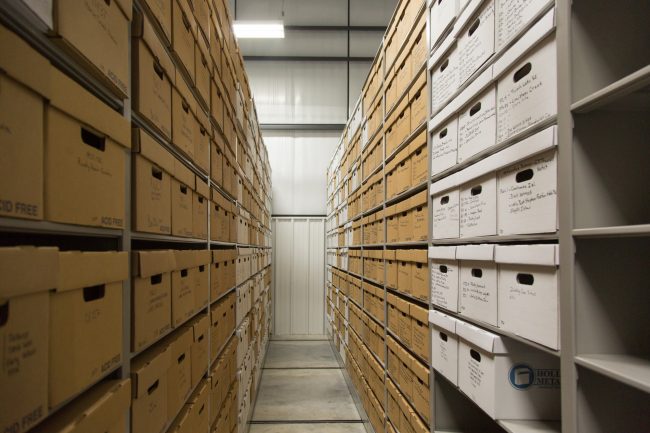R M Bogan Archaeological Repository offers staff, anthropologists state-of-the-art curation and storage

An exhilarated professor points to rows and rows of boxes, eagerly pulling out worn spearheads, withered rocks and tattered fragments. He cannot wait to share the history, the findings of each piece. These artifacts, dating back thousands of years, each tell a story, and Jared Wood, Ph.D., RPA, is thrilled to be the anthropologist to help narrate them.
Wood, an assistant professor in the Department of Sociology & Anthropology at Georgia Southern University, spent years studying Native American settlements and mounds along the coastal plain and Savannah River Valley, and is now focusing his efforts on other understudied parts of south Georgia, piecing together remnants of the various groups that made up the inhabitants of the area as far back as 14,000 years ago. He and his colleagues will use the University’s laser scanning and 3D mapping technology, along with other archaeological techniques, to find patterns that will help determine the belief systems, cultures, settlement patterns and boundaries of the area for the last several millenia.
“This kind of work is like a puzzle,” said Wood. “I get to break out my detective skills to piece together this constantly changing mosaic of humanity.”
Once Wood and his team finish at a site, they bring artifacts to the lab for cleaning, labeling and curating (the process involving organization, conservation, storage and care of artifacts for the long term). It’s easy to imagine that storing of hundreds of boxes, each containing invaluable historical artifacts, in a large enough, safe place, can prove difficult.

Jared Wood, Ph.D.
Until recently, the Department kept artifacts in the secure labs at the Carroll Building on campus; however, thanks to a donation from Rose Mae Bogan Millikan, the staff can now store thousands of boxes and larger artifacts in a secure, state-of-the-art facility.
“When you excavate a site, you have to have a plan,” explained Wood. “You have to know where you’re going to store the material after excavation, how you’re going to preserve it for other generations to study in years to come. This facility will allow us to do just that, and to be able to share it with other researchers and anthropologists in the region.”
The facility, the R M Bogan Archaeological Repository, located at 375 Lanier Drive, opened in May 2017 as part of the University’s new Central Warehouse. It is just under 6,000 square feet, and when combined with the lab spaces in Carroll, creates one of the largest archaeological research and curation facilities in the Southeast.
“As a result of investments by the University and Rose Mae, Georgia Southern is now in a position to offer both undergraduate and graduate students cutting-edge opportunities to work in well-designed archaeology lab and curation spaces,” said department chair Marieke Van Willigen, Ph.D. “Students can now experience the full gamut of professional activities – from excavating field sites to researching and preparing artifacts for curation. Our students couldn’t be in a better position to prepare for graduate school and employment.”
The Repository is one of only three such facilities in the state of Georgia to meet the federal government’s very strict standards for the curation of federally owned or administered archaeological collections. With high-density shelving, climate control, acid-free boxes, electronic access doors and special collections storage units, the Repository allows thousands of artifacts and documents to be kept securely right here on campus.
“The new facility greatly enhances our ability to accept outside collections and will benefit us in terms of research (in house as well as outside researchers), student training, and public outreach,” said Matthew Compton, Ph.D., curator of the Repository.
Wood swipes his secure ID and locks away the keys to the collections storage unit.
“I’m wonderfully overwhelmed with the amount of knowledge to be uncovered in our own backyards,” said Wood. “We live in a wonderful time and place for this kind of science, and we’re so happy to be expanding our own resources for archaeology as a University.”
Georgia Southern University, a public Carnegie Doctoral/Research University founded in 1906, offers 118 degree programs serving 20,673 students. Through eight colleges, the University offers bachelor’s, master’s and doctoral degree programs built on more than a century of academic achievement. Georgia Southern is recognized for its student-centered and hands-on approach to education. Visit GeorgiaSouthern.edu.
Posted in Press Releases

